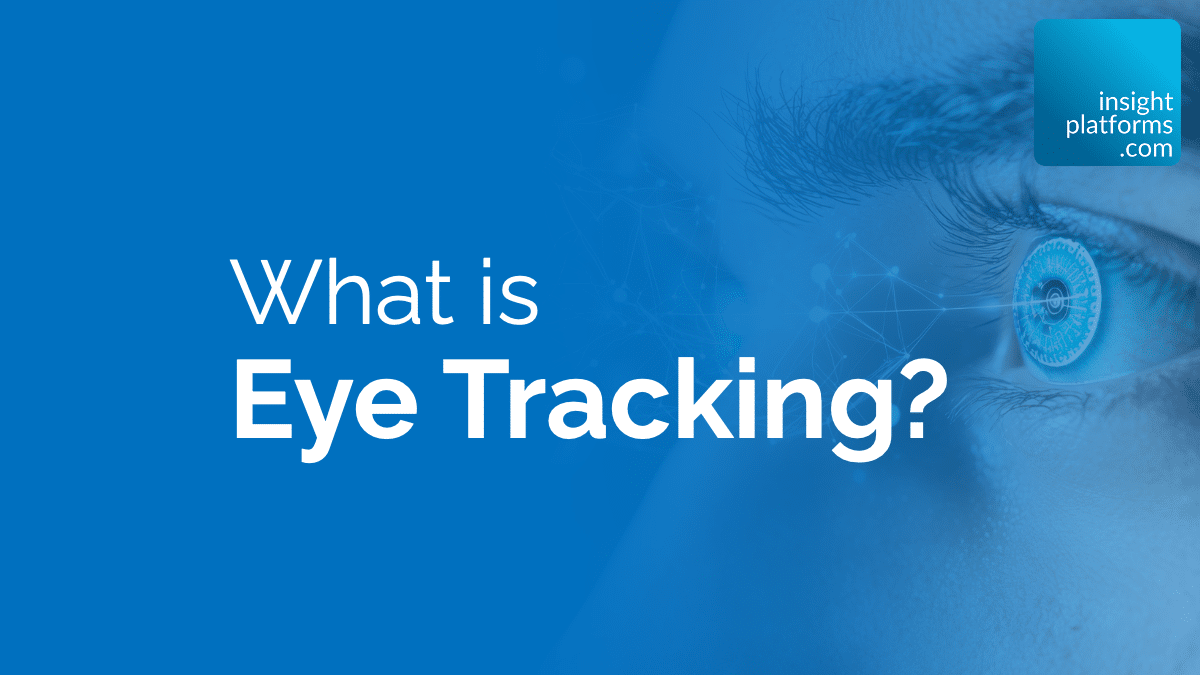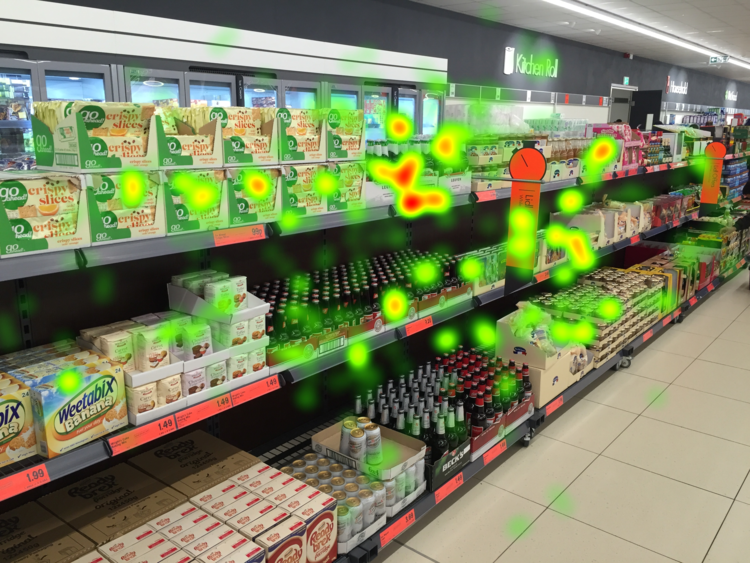
What is Eye Tracking for Market & User Research?
By Insight Platforms
- explainer
- Eye Tracking
- Behavioural Analytics
- Behavioural Tracking
- User Experience (UX) Research
- Shopper Research
- Advertising Testing
- Advertising/Campaign Effectiveness
- Advertising Experiments
- Advertising Tracking
- Neuromarketing
- Wearables
So often we see that what research participants say they do and what they actually do can differ widely. It’s vital to understand real behaviour; to measure what users, consumers or shoppers actually do; and, in this instance, what they pay attention to. That’s where eye tracking comes in. Eye-tracking is a way of measuring attention.
It quantifies what research participants have looked at and how long they looked at it for by monitoring eye movement. This approach records behaviour that is nearly impossible for research participants to articulate, as attention can last for mere milliseconds. You can also ask follow-up questions to measure how much of what people looked at was remembered.
According to the UK’s Market Research Society, eye tracking is “the use of equipment in the observation and recording of a person’s unconscious eye movements when they are looking at a magazine, a shop display or a web site.”
In reality, the applications are much broader.
“Eye tracking allows you to see things from the perspective of consumers. Whether you’re examining product placement, packaging design, advertising, or user experience, eye tracking accurately reveals what grabs attention, what influences purchase behaviour, and how consumers engage with your product. This information helps your business become truly customer-centric.”
Source: Tobii Pro
Stay up to date
Subscribe to receive the Research Tools Radar and essential email updates from Insight Platforms.
Your email subscriptions are subject to the Insight Platforms Site Terms and Privacy Policy.
Methods for eye tracking
There are three main approaches to eye-tracking; wearables, webcams, and predictive.
Wearables are when participants wear glasses with cameras or other equipment that tracks eye movement. This approach enables the technology to be taken anywhere that you want to measure attention, including out of home settings. However, this method can be expensive, and the research participant needs access to the kit to be able to take part.
Webcam eye tracking uses the camera on your device to monitor attention. This allows anyone with access to a camera to take part in eye tracking, though limits the attention measurement to screens. This makes it perfect for videos, websites, or static ads. It can also be used for virtual reality, though you may need to work with another platform to simulate these environments.
Predictive ‘eye tracking’ uses machine learning models trained on historical eye tracking studies to predict where people are likely to look in simulated settings. This significantly reduces costs, as there are no participant costs. That said, the predictions are only useful if the training data contains images like those you want to test. It will only tell you how the algorithm expects people to behave based on past studies. These models do not predict attention for radically new designs. However, these tools can be useful for directional insight, and provide a reasonably affordable sense check for creatives or settings. But we have not included any of these automated ‘eye tracking’ solution in this list. We classify them in the directory under ‘visual analytics‘. For a thorough comparison of ‘human’ and ‘automated’ eye tracking, see this article by Lumen Research.
What is eye tracking good for?
There are a host of different applications for eye tracking. Here are some of the most common.
Shopper

Eye tracking can be a valuable tool for understanding what people pay attention to in a retail environment. It lets you measure a range of elements, like the most eye-catching brands, shelf position or point of sale displays.
This can be done either in a physical store, using eye tracking glasses, or in a virtual reality setting.
Virtual reality store environments allow for consistency, letting you test and compare. You can tweak elements and measure their individual impacts on attention. This could include the brand’s shelf position, different packaging, the number of SKUs, the range of competitors, and different display designs.
Alternatively, you can use a bricks and mortar store to see what grabs attention in a real setting. This allows you to test specific stores, or ‘real’ behaviour in the field.
UX Research
Understanding what users pay attention to when they interact with your website or app is key.
Eye tracking can be useful for UX research as it can pick apart online behaviour. It can help you see whether a call to action on the property is getting the attention it deserves. It can also help you see how users are navigating your site, to see how intuitive it is. Are buttons where people expect them to be? Are people reading or ignoring key information?
This insight can then be used to optimise digital properties to make them work harder for your brand and customers. Additionally, data can be used to justify price points of certain inventory, if certain areas of the site get more attention than others.
Advertising
Eye tracking is a great way of enhancing visual advertising research, both before and after a campaign has gone live. You can use it before to test the advert, to ensure success. Alternatively, you can test it after it is live to measure engagement. Eye tracking shows how consumers view advertising and lets you capitalise on the most effective elements.
There’s a number of ways that eye tracking can help advertising. You can compare attention for your campaign to others in the same format or category. You can see which creative elements are driving the most attention (is the brand name, the offer, the talent, etc.).
Additionally, you can measure the impact of other attributes on attention. How much impact does context have on attention (does the same ad get the same attention in different settings)? Does higher frequency of ad exposure result in more attention?
This can be used to make your advertising more influential by understanding if it captures attention and creates engagement.
Packaging
Eye tracking can be useful for improving and evaluating packaging designs, both new and existing. It can help ensure that your packaging stands out above competitors, improving the chance of consumers picking your brand first.
There are a few options for this approach.
You can use a store environment (similar to the shopper approach) by seeing if the new design stands out more on shelf than the original or competitors.
Alternatively, consumers can interact with a finished or mocked up packaging design, while you measure which elements are the most eye catching.
If you’re redesigning the product, you can measure whether the new design attracts more attention than the original. You can also pinpoint specific behaviour, like whether people notice the new flavour variant, the special offer on pack, or the call to action.
Case studies
Optimising BT’s Direct Response Advertising – Lumen
BT partnered with Lumen to eye tracking to boost attention and impact of their direct response advertising.
The print creatives they tested highlighted the power of images in gaining initial attention, before delivering the details of the deal.

“The learning from the eye-tracking research we did with Lumen was fundamental to the creative development and success of the BT campaign.”
Julian Earl, Strategy Director – AMV BBDO
Furthermore, the eye tracking insights could also be applied to TV advertising. This led to additional 3,700 sales in first six months (50% over forecast).
Improving package design for Unilever – Tobii Pro
Unilever partnered with Tobii Pro’s research consultancy division to run eye tracking based shopper studies.
Shoppers wore eye trackers to measure their attention as they engaged with products on the shelf. This revealed what elements shoppers were drawn to, how they visually engaged with various branding or marketing features, and what role this interaction had on their behaviour.
“Using eye tracking gives you the opportunity to look through the consumer’s eyes, so instead of only listening to an opinion we now see the analysis…and when we need a specific answer to a question, we use a lot of eye tracking because eyes don’t lie.”
Jeroen van der Kallen – Customer Insight and Innovation Manager Europe, Unilever
The findings from the study helped Unilever determine what design and information features resonate most with shoppers allowing the company to optimise brand awareness and brand perception.
Data visualisations were used to help interpret the results and share the information with various stakeholders. This insight on product and branding features enabled Unilever to make continual improvements to increase sales and the research methodology is now routinely used by the company.
Further resources
If you’re still looking for more information about then we’ve got you covered. Check out our Eye Tracking page, for a range of blog articles, webinars, demos and platforms. Alternatively, we’ve got some content here for you to read or watch.

